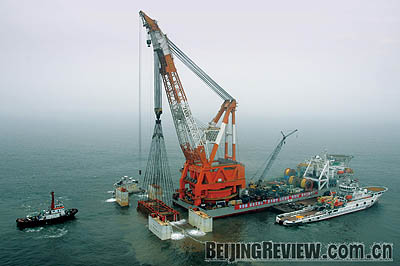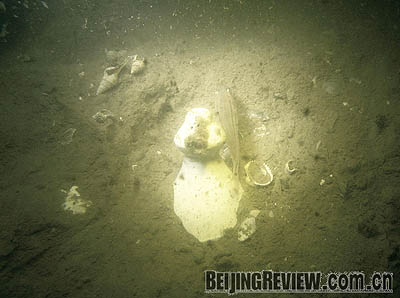|
 |
|
DELICATE OPERATION: The 800-year-old shipwreck Nanhai No.1 is lifted out of the ocean off the South China Sea coast in December 2007 (ZHANG JIANWEN) |
Few things attract interest in history more than a sunken shipwreck. But the survival of wooden ships underwater is a matter of luck, with oxidization taking its toll and marine organisms capable of eating a vessel completely unless buried under specific geological conditions such as extreme cold or under a covering of silt.
The recent recovery of the wreckage of a merchant ship loaded with exquisite porcelain, has given the world a new opportunity to understand the life and trade of the Chinese people and their business partners 800 years ago.
The 30.4-meter-long and 9.8-meter-wide ship dates back to the early Southern Song Dynasty (1127-1279). The sea bottom where the wreck was found was about 25 meters under water and the ship was covered by silt more than one meter thick. Lying on the sea bottom for such a long time, the ship, named Nanhai No.1, surprisingly had stayed upright. Judging by the porcelain products excavated from it and the direction of the ship head, archaeologists estimated that the vessel was likely to have sunken on its way to Southeastern Asia or the Middle East countries for trade.
The ship's contents cast new light on the development of China's porcelain trade in the Southern Song Dynasty, with tableware was being made particularly to suit the tastes and dinning habits of customers thousands of miles away.
A popular theory among Chinese historians is that since China's Han Dynasty (206 B.C.-220 A.D.) or even earlier, Chinese merchants on the coastal regions had been engaged in shipping porcelain, cloth, silk and probably grain seeds from ports of southern Guangdong Province to India. Then these Chinese goods were sold to people in Egypt and Rome. This trading path has been named the Marine Silk Road, and dates back earlier than the better-known overland Silk Road. Many people nonetheless have doubted the existence of such a trading path due to lack of evidence. The discovery of Nanhai No.1 goes a long way toward proving its existence.
Extremely fragile
Nanhai No.1 has been acknowledged as the largest, oldest and best-preserved shipwreck in China. It also has created another national record as the most expensive excavation project.
 |
|
BENEATH THE SEA: Photograph of porcelain on the deck of the shipwreck taken underwater by an archaeologist (LIU ZHIYUAN) |
After the shipwreck was located in 2001, archaeologists met with enormous difficulty in designing a salvage plan. If they chose the traditional method of first excavating relics piece by piece, then the information on location of items on the ship would be lost forever. Moreover, after being soaked in the water for at least 800 years, the ship's body was extremely fragile. After all the items on it were taken away, an even bigger challenge would be how to lift the ship out of the ocean.
To better protect the wreck and avoid damage during the excavation, experts of Guangdong Provincial Institute of Cultural Relics and Archaeology and Guangzhou Salvage Bureau worked together and creatively suggested using a steel box to hold the wreck and its surrounding silt as they were hoisted out of the water.
Wei Jun, a researcher from Guangdong Provincial Institute of Cultural Relics and Archaeology, said since 2002 the State Administration of Cultural Heritage had conducted four appraisals on the salvage plan, which had been improved over the process. The plan was finally adopted in June 2006 and his institute signed an outsourcing salvage contract with Guangzhou Salvage Bureau in December 2006.
In January 2007, the command center of the salvage mission was set up and the Ministry of Finance allocated 30 million yuan ($4.3 million) for the project, making it China's second most expensive cultural heritage protection project after the renovation of Potala Palace in Lhasa. The same month, Guangzhou Salvage Bureau began to send out salvage expeditions to measure the ship ready for its move. At this preparatory stage, nearly 500 items had been salvaged, including metal items, porcelain, copper coins and broken pieces of lacquer.
To box the ship out, Guangzhou Salvage Bureau manufactured a bottomless steel cage weighing 530 tons that was 35.7 meters long, 14.4 meters wide and 12 meters deep. After the open side of the cage was pushed into the seabed, divers put 36 steel beams across the bottom of the cage to hold the ship. The first beam was placed on September 4. The placement process took much longer than expected due to a particularly hard mud layer and was completed on November 13. Then divers put 37 steel plates, each 12 mm thick, in the gaps between the 36 steal beams, forming a bottom for the cage.
| 